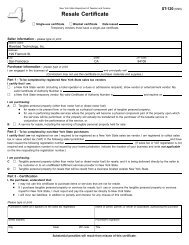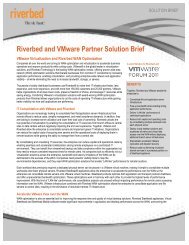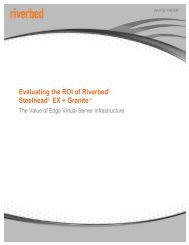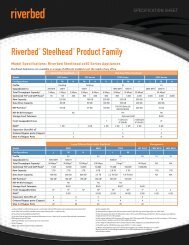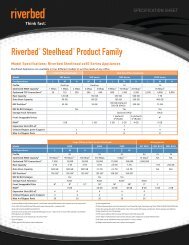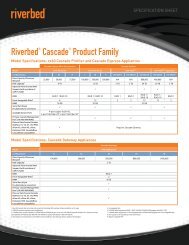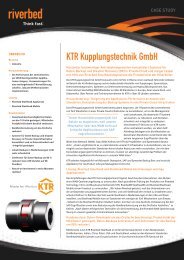Riverbed Optimization System (RiOS) 6.1
Riverbed Optimization System (RiOS) 6.1
Riverbed Optimization System (RiOS) 6.1
You also want an ePaper? Increase the reach of your titles
YUMPU automatically turns print PDFs into web optimized ePapers that Google loves.
<strong>RiOS</strong> Technical Overview<br />
Figure-11: Application streamlining can eliminate up to 98% of roundtrips generated by application protocols.<br />
It is easy to talk about “application streamlining” as a concept, but harder to deliver real performance improvement. <strong>Riverbed</strong> was<br />
the first vendor to deliver this method of layer 7 application protocol optimization, and no other vendor has as complete a range of<br />
application-level optimizations. Even vendors who offer some application-level optimizations for CIFS or MAPI often don’t deliver<br />
the quality or depth of optimizations that <strong>RiOS</strong> does. With application streamlining, the evaluator of various technologies must dig<br />
beneath a standard checklist to see how deep and in what ways a vendor can streamline the application.<br />
It should be noted that Steelhead Mobile provides acceleration of all applications running over TCP, but certain application<br />
streamlining modules are not currently available for the software client. More details on product specific features can be found in<br />
the feature table at the end of this document.<br />
Windows File Sharing (CIFS) <strong>Optimization</strong><br />
Many vendors claim to have application-level support for CIFS. Yet, if a user makes changes early on in a file (for example,<br />
changing the title of a Word document), some other vendors’ products treat the rest of the file as though it were completely new<br />
data. Additionally, there are many ways to use CIFS. When some competitors claim they ‘do’ CIFS optimization, often they only<br />
optimize drag-and-drop file copies.<br />
<strong>RiOS</strong> contains about a dozen CIFS optimizations for various operations such as file sharing, folder browsing, accessing files from<br />
within other applications, and more. Furthermore, some applications make use of CIFS with complex file-locking arrangements.<br />
Other application acceleration approaches may break these locks, or simply not be able to optimize performance in these cases.<br />
<strong>RiOS</strong> has built-in technology which allows application acceleration to be optimized, with appropriate file locking maintained.<br />
Even Apple Mac clients for CIFS can benefit from these same application specific optimizations to overcome latency. This<br />
optimization works for Mac OS 10.5.x (Leopard) and newer clients when they connect via Steelhead appliances to typical CIFS file<br />
servers such as Windows Server and NetApp.<br />
SMB Signing Support<br />
This feature allows customers who serve files from domain controllers where Microsoft’s SMB signing is set to required by default<br />
to protect themselves from “man in the middle” attacks. This feature gives support for CIFS latency optimizations in the presence<br />
of signed packets. SMB signing support has been further enhanced for easier configuration and to work across multiple network<br />
domains.<br />
Lotus Notes <strong>Optimization</strong><br />
Developed with IBM, this application specific optimization improves the sending of large email attachments with a performance<br />
gain of up to 8X to 25X. This release also optimizes server-to-server replication, calendaring, and more. <strong>RiOS</strong> transparently<br />
switches off transport compression so Notes/Domino traffic for all applications can be more effectively optimized by the Steelhead<br />
appliance and Virtual Steelhead.<br />
© 2010 <strong>Riverbed</strong> Technology. All rights reserved. 13



